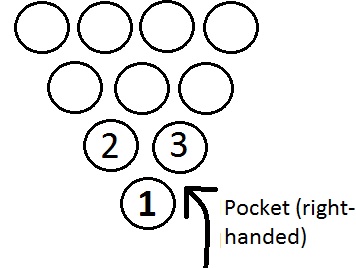snipped the first part...
When you do the drill and hit the cue ball straight up table it will come straight back with center (which is a great drill for for accuracy), however with the TOI it will spin about a half a diamond the direction you're cuing it...TOI LEFT will come back a half a diamond to the left for example.
Oh, so the TOI inside method is imparting inside English after all.
At any rate, we now have something we can test.
We can all try the shot 10 times each way. You shoot it 10 times with center ball and see how close it comes to your tip. Then you shoot it 10 times with a TOI inside and see how many times you can get it to return to the exact same spot, but on the first shot you have to have a designated target to make it even.
Here's were I have to be careful not to jump to conclusions because I'm not sure what's going to happen. I'm thinking that you will get a similar spread between the two. With the center ball shots sometimes missing to the right of your tip and sometimes to the left. The touch of inside shots should sometimes spin more than a diamond and sometimes less. Not entirely sure about this, but I do think it's something we can work with.
Now let's say the spread is about the same, what would this tell us? (You may need more than 10 shots each to get a legitimate sample size, I don't know). That either way you cue you have stroking errors that you have to deal with. So why not just aim for the center of the pocket and let your errors take you to one side or the other of the pocket? This seems reasonable to me, except if you KNOW FOR SURE that all of your stroking errors are on a specific side of the cue ball. In that case, the TOI technique may work.
Oh but wait a second, if you know that your stroke ALWAYS generates errors on a specific side of the cue ball, why not just address that to begin with? After all, you have some really useful information to work with - that is you know that you are for some reason cueing off every time to one side or the other. Heck, if you want to you could just start cueing slightly off the center of the cue ball in order to hit it dead center. Then you could aim for the center of the pocket, which is where I think we all naturally want to aim to begin with.
Well, now what if the test results show you are more accurate with the TOI technique?
First, I think you should start lagging using this technique.

Which, by the way I have noticed that Darren Appleton (as someone on AZ pointed out) tends to lag at a slight angle. Which is interesting...I wonder if he cues with a bit of English or if he slightly angles his lag shots???
Secondly, maybe somehow this WOULD show that cueing for a bit of English is more forgiving than cueing for center ball. I don't really see how that would be, put it's above my pay grade and I would have to defer to those that are more knowledgeable in this department.
I am going to try out those test shots just to satisfy my own curiosity and see what I find.
I'll report back at a later date.
***EDIT***
I suppose the reason the TOI shots could come back to the left of the starting position could be just from the squirt and the imparted English could be worn off before hitting the cushion. These would have to be very soft strokes though. That would be more inline with what CJ has been saying from the beginning about NOT using English with using the TOI technique. I just had that thought a moment ago.

